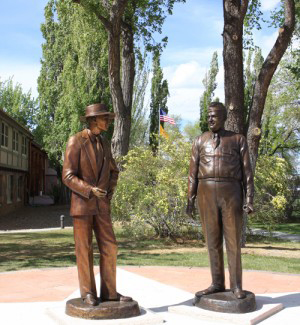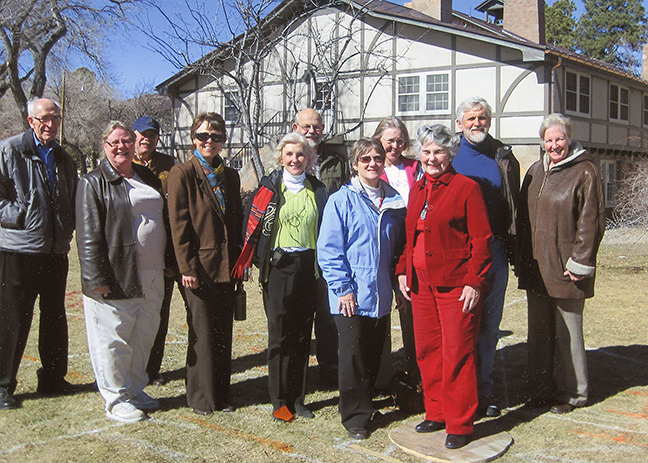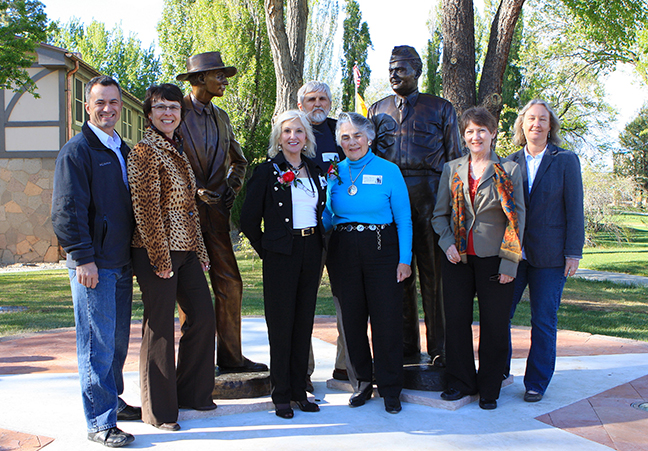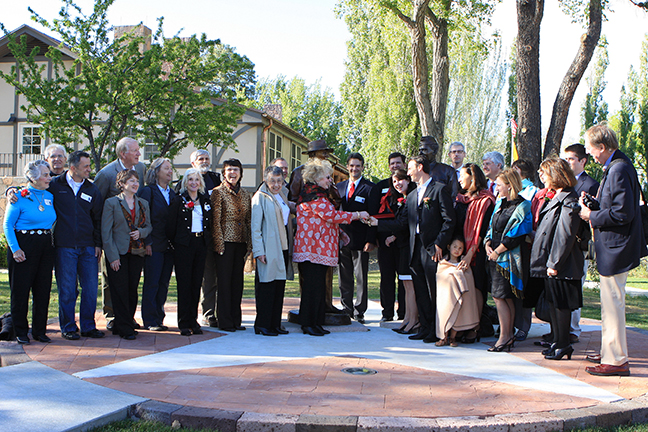|
|
|
Dedication of Historic Sculptures Master Plan
Southwest Oral History AssociationSummer 2011 Newsletter Los Alamos, NM Report on the May 19, 2011 Ceremony Nancy R. Bartlit, Author/Historian Historic Sculptures Master Plan Chair Los Alamos Art in Public Places Collection Dedication of the Dr. J. Robert Oppenheimer and General Leslie R. Groves Statues  On May 19, 2011, Los Alamos hosted two new bronze life-size sculptures of Dr. J. Robert Oppenheimer and General Leslie R. Groves and their grandchildren and great-grandchildren who came to witness and comment at the dedication of the two sculptures created by the gifted artist Susanne Vertel of Santa Fe. The dedication of these two historic figures, who selected the Los Alamos Boys Ranch School to become the home of the Manhattan Project research during World War II, was the culmination of seven years of effort on the part of members representing the Los Alamos Historical Society Board, the Fuller Lodge/Historic Districts Advisory Board, and the Los Alamos Art in Public Places Advisory Board. A ten-year Master Plan for historic sculptures was prepared by an ad hoc committee, received appropriate approvals, and accepted by the Los Alamos governing body. The Plan identifies historic figures or representative figures to represent the five eras of the Los Alamos Plateau: Ancestral Pueblo, Homestead, Ranch School, Manhattan Project, and Cold War. Six of General Groves' grandchildren and one great-grandson came from the United Kingdom, the East Coast, the Gulf, and the West, to learn more of the history of Los Alamos during World War II. Several shared their thoughts at the ceremony and agreed to give oral history interviews. Charles Oppenheimer, grandson of Dr. Oppenheimer, brought his family and sister to be present and to share his thoughts. Former Los Alamos National Laboratory Director John C. Browne, explained the legacy of the decision of these two wartime leaders to locate in Los Alamos, and of the research results that help to keep America secure, especially techniques to thwart terrorists identified since 9/11. Dr. Alan J. Hurd, in charge of Rosenfest, and his steering committee coordinated the dedication of the statues with their symposium to honor Dr. Louis Rosen, a scientist who spanned the Manhattan Project and the Cold War by promoting the development of an accelerator that assists studies of the behavior of protons and neutrons. Isotopes are made and delivered to hospitals for medical applications from this research as a practical application. Today we are dedicating the legacy of two men who represent The Manhattan Project Era on the Pajarito Plateau. 
From left to right: Art Freed, Oppenheimer Memorial Committee rep, Stephani Johnson, LA County staff for Art in Public Places Board, Richard McIntyre, Parks Manager and designer of the base for the statues, Linda Deck, Bradbury Museum Director (CM), Susanne Vertel, sculptor, Gerry Strickfaden, Chairman of the Fuller Lodge/Historic Districts Advisory Board (FL/HDAB), Hedy Dunn, then Museum Director of the Los Alamos Historical Museum (CM), Nancy Cerutti, LA county staff for the FL/HDAB, Nancy Bartlit, Chairman of the Historic Sculpture Master Plan and member FL/HDAB (CM), Ron Wilkins, past Chair of the FL/HDAB and Treasurer of the Los Alamos Historical Society (CM), and Katy Korkos, Member Services Coordinator for the Los Alamos Chamber of Commerce. Why are these men standing together in New Mexico? We expect future visitors to our town to keep asking this question. One man was from New York and took his Ph.D. in Germany. The other graduated from West Point, then supervised the building of the Pentagon. These two gifted leaders worked in unusual partnership to develop and test the world’s first atomic weapons. Their use ended World War II. General Leslie R. Groves in his autobiography said, "That we were successful was due entirely to the hard work and dedication of the more than 600,000 Americans who comprised and directly supported the Manhattan Project." [Now it can be told, General Leslie R. Groves, p. 414. 
From left to right: Brian Hurshman, Linda Deck, Susanne Vertel, sculptor, Ron Wilkins, Nancy Bartlit, Chair, Hedy Dunn, Ellen McGehee Missing From Photo: Helen Baran, Katy Korkos, John Hofmann, Pat Walls. (Photo courtesy of Leslie Bucklin) In 1942, General Groves became the commanding general of the U.S. Army Corps of Engineers' Manhattan Engineer Project, named after its initial headquarters in New York City. He selected Dr. J. Robert Oppenheimer, an outstanding scientist and teacher of nuclear research--beloved by this community--to be the wartime laboratory director of Project Y. Together they selected the Los Alamos Ranch School to begin American and Allied joint secret nuclear research. Their rare efficiency was driven by the dire circumstances of America fighting two simultaneous wars: one against Nazism in Europe and one against Japanese Imperialism in Asia. Both were very formidable foes. The consequences of these actions are still debated, but let me share some of my experiences. Only 13 years after World War II ended, I taught school in Japan. The scars of the war were still evident in Sendai as I traveled to work. I was told, "We [Japan] started the war; you [America] ended it." Later, for my master's thesis at UNM, I analyzed the comments written fifty years after the war in the ledger placed beside the Public Forum Wall in the Bradbury Science Museum. Visitors wrote their thoughts about the dilemmas of using the new weapon. The comments from all over the world were very diverse, but none disputed, "War is Hell." And veterans pledged to fight again to defend the right to disagree. One entry spoke to me, "Neat and sad."  On the day of the dedication this historic photo was taken of three distinct groups of people: On the left, are the members of the Council-Appointed Committee, assigned the task of spearheading the production of the portrait bronzes. Susanne Vertel, the sculptor who created the two pieces, stands within that group with the red rose on her lapel. Next, are the Los Alamos County Council members and the group on the right is made up of Oppenheimer and Groves family members. (Photo courtesy of Leslie Bucklin) Last fall (2010, ed.) Los Alamos dedicated, on the south side of Ashley Pond, a Historic Marker for two highly regarded women who lived at different eras of Los Alamos history–one during the Ranch School Era, and the other during the Cold War Era. Today's dedication of the first two bronze historic figures is the culmination of hours, no, years, of commitment. Many shared the vision of re-stirring history and its scenes, through this art form. Members of the Historic District Master Plan Committee built on the ideas which went before them to nudge the Art in Public Places Board to begin with The Manhattan Project Era. Former, and present County Councils, especially our council liaison Ralph Phelps, encouraged our efforts and trusted us to recommend the best site for these statues and a ten-year master plan. To start the work at Los Alamos, bulldozers began leveling the local landscape in the spring of 1943. A little more than two years later, the atomic weapons were delivered for use in the summer of 1945. It took longer to approve and execute these statues than it took to produce the first atomic bombs! But, we did not face such dire times. Yet, now we are under way. You should have watched the alacrity of Parks Manager Dick McIntyre to design—and his Los Alamos county crews to prepare—the appropriate base for the Oppenheimer and Groves statues; and indeed, the sculptor Susanne Vertel made sure that her second statue was finished just in time for the Rosenfest dedication! We all applaud our Santa Fe sculptor, whose works for Los Alamos stimulate the imagination, Susanne Vertel! ❇ |